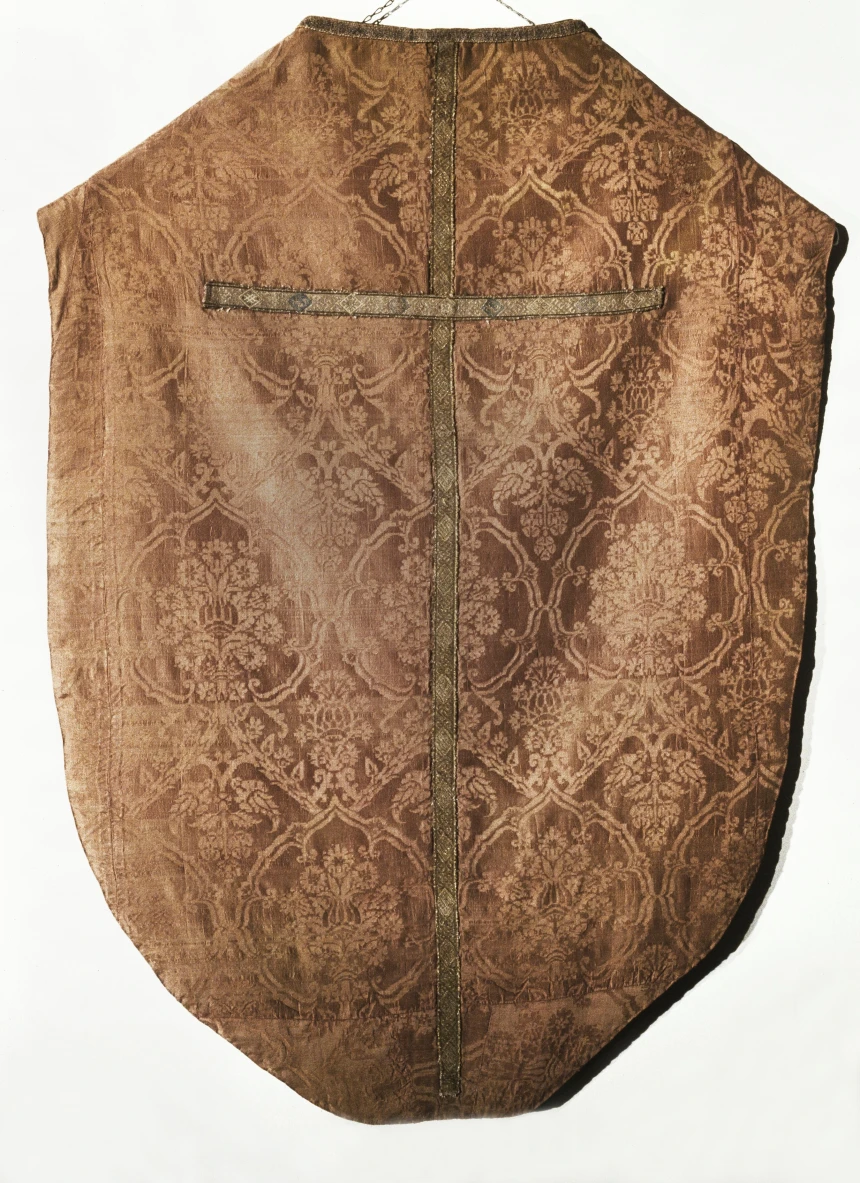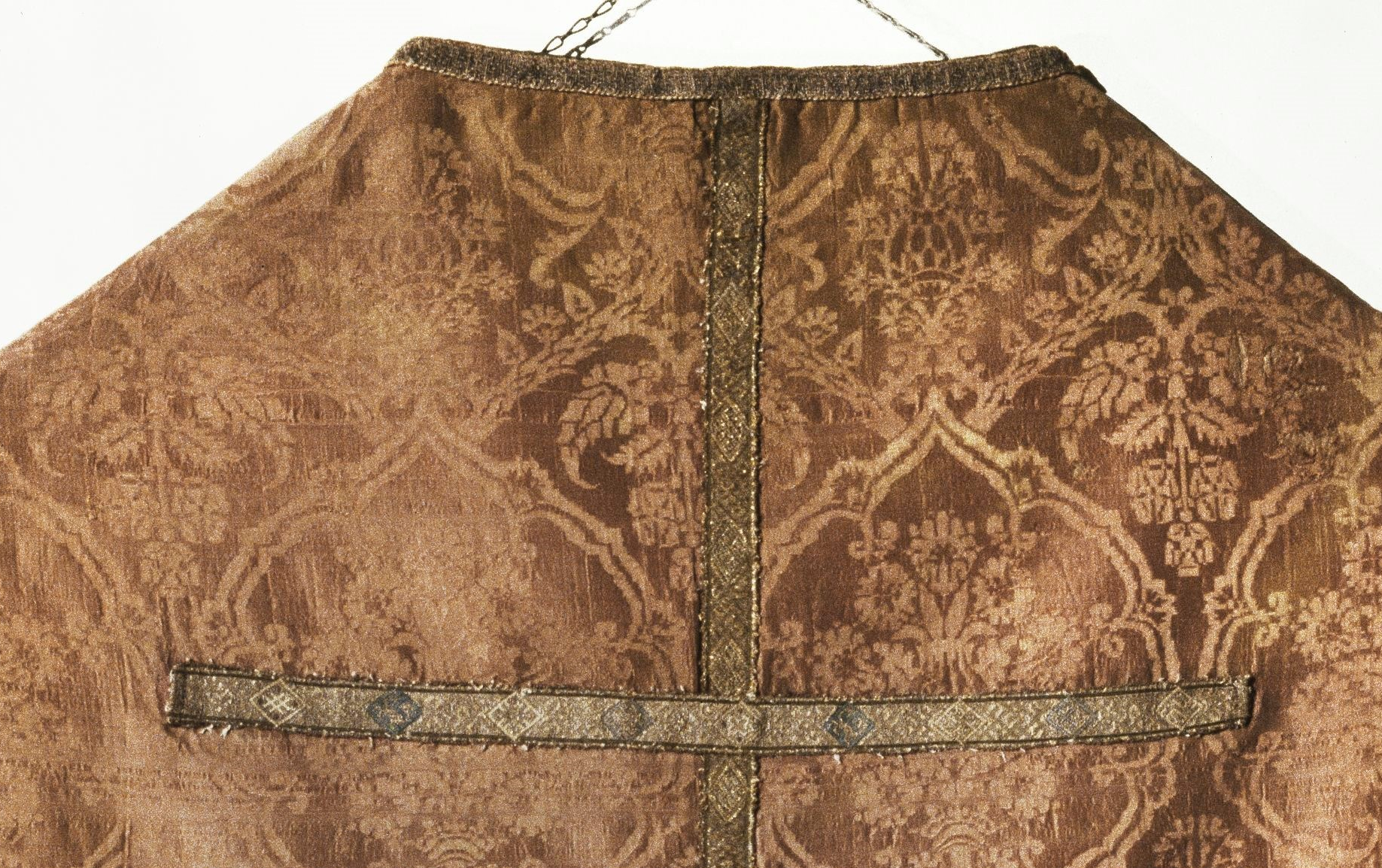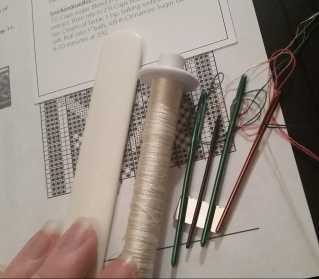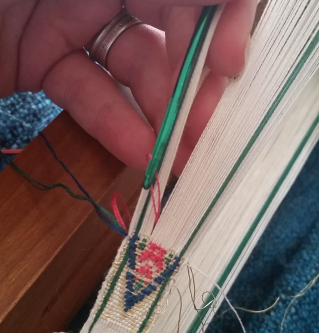Multiple Color Brocade Tablet Weaving
This chasuble was acquired by the Swedish Historiska Museum in 1893. It was displayed in 1997. The band that forms the back cross is 2.4cm wide, about .94 of an inch. It was woven in silk and gold but is also brocaded with additional silk in several colors.
Of particular interest in this piece – the same pattern is used on multiple bands on the garment. Twice on the cross on the back, and once at the neckline. However, the bands were woven differently using different materials. The vertical branch of the cross uses the colored motifs, but only in the lighter colors and is more similar to the collar band than the horizontal band of the cross.
Notes
* Illuminations from this time frame depict women tablet weaving on a standing frame loom, such as this 1410 painting from the Mazarine Bible. However, there is not a way to tell what type of loom was used on a specific piece. I actually have a standing frame loom on order (to be delivered Mid-May) but am currently working on this piece on an inkle style loom. One of the biggest differences this makes is how frequently you advance the project (I have 12” of working room versus 36” on a standing frame loom) as well as dealing with twist. Using a circular warp on an inkle loom requires that twist from turning the cards be reversed within the weaving. Using a frame loom would allow one to untie and untwist the threads without reversing the weaving.
** I used 60/2 silk for this project to create a piece as close to the actual size of the original as possible. However, I did have limited colors in this size due to expense. Therefore, I changed some of the colors but tried to keep the overall look of the band similar to the original.
***The original band has 3 colored motifs alternating with 3 gold motifs (color 1, gold 1, color 2, gold 2, color 3, gold 3, repeat) however one of the gold motifs is known modernly as a swastika. Due to it’s modern association I chose not to use this motif and to instead alternate the other two gold motifs.
There are several descriptions of the warp threads that directly conflict each other. The earliest public analysis is by Agnes Geijer in Some Medieval Bands, published in 1928, and lists it as having two threads of silk and two of linen, but in the same color. Nancy Spies in Ecclesiastical Pomp & Aristocratic Circumstance, 2000, states that the band has the center threaded all silk, but with two threads of light yellow and two of green. When carefully examining available images, I don’t see the striping that should have resulted from either of these descriptions. I’ve contacted the textiles curator, Amica Sundström, at Statens historiska museer (the museum branch holding this piece) and am currently awaiting more information and closer photos of the band in particular. Part of the discrepancy may be due to the presence of two separate bands on the same garment.
For this project, I chose an all silk warp. The two outermost cards on each side were threaded with cream silk in all 4 holes, the next two inward with green silk in all 4 holes, and the 27 center pattern cards were threaded with all 4 holes of ivory silk.
Initially I used the same 60/2 cream colored silk as the warp for the weft. Both gold and colored brocade threads were used double. The gold brocade was threaded within the band but did not go all the way to the outside card. I used a bone folder to pick up the pattern threads and threaded the gold through on a large needle, turning under the band just before the last card.
Colored brocade threads were also used double but did not go through the middle of the band like the gold thread. Previous experimentation showed that using multiple colors of thread inside the warp created a very bulky weft that would not pack tightly to show a neat pattern. Instead, these colored brocades wove completely below over all four threads of the band, similar to embroidery. This did mean at any one time I was managing 5 different weft threads: 3 colors, one gold, and the primary silk weft. It quickly became apparent that doing each row in the exact same order was key to keeping the pattern consistent.
The first colored motif worked out the basic technique but was far more elongated than the original band. I loosened tension and worked through a gold motif, but still found the pattern to be too long.
At the second colored motif, I changed my weft thread to a fine silk sewing thread instead of the 60/2 silk I was using. The pattern was much better, but still not where I wanted it to be.
After the second motif I loosened up tension even more, and success! The third motif was far more like the original band. This was incredibly loose tension, letting the cards hang loosely by 45 degrees or more. I’ll continue the band with this loose of tension.
I also ordered an even finer silk thread, 100 weight sewing thread, and after the third motif used this for the primary weft along with greatly reduced tension on both the warp and weft. This section is the closest to the original in dimensions, although it is still narrower. At this point, my band measures .75” instead of 94”.
Bibliography
Geijer, Agnes. Some Medieval Bands. Journal of Swedish Antiquarian Research. 1928.
Book available online at: http://samla.raa.se/xmlui/bitstream/handle/raa/878/1928_001.pdf?sequence=1
Spies, Nancy. Ecclesiastical Pomp & Aristocratic Circumstance. Arelate Studio. 2000.
Sundström, Amica. Textiles curator at Statens historiska museer. Personal interview. 25 April 2018.
Textile Collection, Historiska Museum. Acquired in 1893. http://historiska.se/upptack-historien/object/95622-masshake-av-textil/ Accessed 2 May 2018.
Special Thank you to Maria of https://historicaltextiles.org/18-2018-the-weekend-pictures/ for updated photos of the chasuble!
The Statens Historiska museum has an amazing collection of items and documentation, including copies of their ledgers and inventories! The images below are fun documentation I found during my research.
Appendix 1: Original Catalog entry from the History Museum of Sweden.
Google translate of the Swedish typing: Mittlinjens h. Front, 86, behind 107.
Pale brown, originally rc stemmerd side door, pomegranate pattern with uncomposed crown; Italy. 14 2nd half of the 2nd century; 5-sheath satin finishing. On the backside a simple cross formed of a gold and multicolored silk brooch band, the Middle Ages.
Around the neck, easier brick tape. Blue linen lining, Ur-sprung medieval shape.
Canned 1942/43. Prnr 2168/42.
Litt. Geijersgatan; Ancient 1928. Some medieval bands. Dep. .1893.
Appendix 2: Exert from Some Medieval Bands, Journal of Swedish Antiquarian Research. Geijer, Agnes. 1928.
Translation (by Google): The very well-preserved band from Ösmo is a typical one washer belt. The same braids arranged the bricks nods each of two coarse linen threads and 2 finer yellowish silk threads, like the second outermost pair, which is completely of green silk. The braids, which are held together by an invisible feature, form a smooth side. Across the right side, the wrap is double gold thread, “real gold”, which is bounded by the green ones the brick strings partly of the yellow silk wires so that a weak, oblique pattern is formed. Against this gold bottom appear on periodically in the grooved boxes inscribed ornaments, performed with Blue, yellow and white (possibly originally even more colors) as well as black.
The band is 24 mm. wide and forms the cross to the back of one Mässhake, which was handed over by Ösmo parish in 1893 The National Museum of History, where it is part of inv. No. 9300. Brass fairy is made of now faded, originally red Italian side décor with pomegranate pattern from the 1400s and lined with blue linen. The neckline is lined with a narrow band of the same type, although much coarser in quality and of worse gold thread (now darkened “bowel gold”, spun around linen) as well without brochures. Although a pair of seemingly unmotivated bugs at the bottom of the page and a joint on the band could indicate that this use is secondary for both the band and the page, however, you should be able to date it all up to the 1400s. gold’s quality is typical for this time, and the band’s structure is reminiscent much about the many embroideries with figures against gold foundation we feel from the end of the 1400s. Transition to just this kind of embroidery is a Röhsska. The museum’s associated band, which is an interesting evidence of the brick tissue seglivenhet. It forms the background for a madonna image, as a ready-made embroidery applied to the band. The picture suggests that although quite roughly done, in a certain skill; it would be a German work from the beginning of the 15th century or mine. The band is technically similar to the Ösmoband, solid coarser, and has one all over the surface is oblique pattern, which looks very similar to appearance the underfilled bedstrap with gold thread embroidered the surfaces, which distinguish the German and Dutch late-medieval embroideries. In all likelihood, these are embroideries, such as the miss SYLWAN orally pointed out to me, just inspired by such brick weave bands.
Appendix 3: 1893 Ledger Entry from the Historiska Museum. The chasuble and band are Item # 9300.












